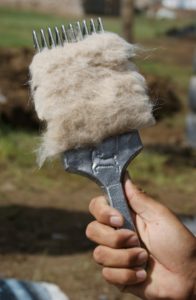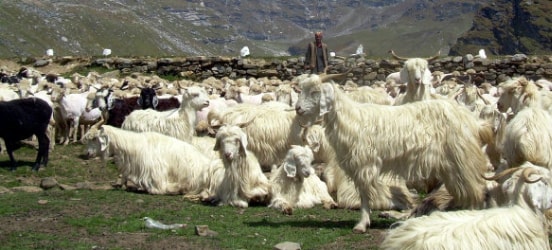The production of 100% cashmere clothing as seen on Cashmere Mania is a long and cumbersome process, and in this article we would like to share the exact steps.
In order to collect the cashmere, each goat is combed by hand every spring, when cashmere fiber starts to loosen, and the Kashmir goat changes its coat.
The coat keep the goats warm in temperatures that can drop as low as -40̊F in the winter.
Then collected locks of hair are left on stairs and shrubs.
The most common method of producing cashmere wool is by separation of the soft undercoat hair.
For the production of cashmere sweaters only the finest quality fiber is used. The cashmere sweater you have in your closet is produced of wool obtained from tens of cashmere goats, because one gives only a small portion of the fines fiber. That’s one of the reasons why is cashmere so expensive.

The collected raw cashmere is processed mainly in the countries of its production – for example in Mongolia, China or Nepal.
Nepal is one of the poorest countries in the world. The production of cashmere clothing and carpets is one of the main crafts in this Himalayan country.

The way of cashmere production and processing is transmitted from generation to generation in Nepal.
They prepare the raw cashmere for processing, washing and sorting.
Fibers that do not meet the required standard for quality are discarded.
After this, it follows drying and dyeing of cashmere. The goat’s undercoat natural colors are white or black. These are mixed with shares of other colors, as they respond well to dyeing.
When dyeing of cashmere is done, it follow the most important part in the process of cashmere production – weaving.
Here is a video that demonstrate hand weaving a cashmere and silk scarf.
To maintain quality, cashmere fibers are processed manually.
For now there is no method for automated processing of 100% pure cashmere. In China, they’re trying to enforce automated production by artificial insemination of Cashmere goats.
They really succeeded to lower the cost of production, but the end product lost its quality at the same time.
If you want to enjoy the full pleasure of 100% cashmere, we recommend buying cashmere clothing produced by hand in Nepal or Inner Mongolia.
These manufacturers can guarantee the high quality of their cashmere.
Don’t forget to check out our pure cashmere collection on sale.

